A Few Early Films Starring Chiezo Kataoka
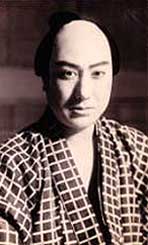 Chiezo Kataoka (1904-1983) became one of Toei Studio's main stars in minor adventure films in the 1950s & 1960s, basically a B-film actor who brought an extraordinary sincerity to every role.
Chiezo Kataoka (1904-1983) became one of Toei Studio's main stars in minor adventure films in the 1950s & 1960s, basically a B-film actor who brought an extraordinary sincerity to every role.
His aged, rugged features scarsely recalled that he had once played "pretty" samurai in silent & early sound films.
In the silent era & early talkie era, Chiezo was a powerhouse of a film idol, strongly associated with period roles.
When he was at Nikkatsu studios he was named as one of "the three treasures of nikkatsu" together with Tsumasaburo Bando (1901-1953) & Kanjuro Arashi (1903-1980), the most popular film actors of the era.
In 1928 he became a producer as well, heading up his own film studio, as did Tsumasaburo Bando, not only so they could control their own acting careers but so that they could encourage advances in the film literature that moved more toward realism of character & event, & less reliance on the benshi or live film narrator, in order to make events fresher than the limited benshi repertoirs.
At Chiezo's film company, Hiroshi Inagaki (1905-1980) made his directorial debut with The Wandering Gambler (Horo Zanmai, Chie Productions, 1928). It is sometimes called Wandering Samurai, but this is incorrect as he is playing a toseinin or wandering yakuza, a gangster or gambler of the peasant class.
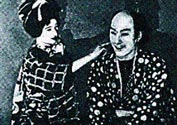 In the surviving The Wandering Gambler, Chiezo looked fierce & wild, & drew on his kabuki stage experience to create amazing stances & ferocious action, resulting in untidiness of costume & weary broken movements such as heros were generally not permitted to show. In the surviving The Wandering Gambler, Chiezo looked fierce & wild, & drew on his kabuki stage experience to create amazing stances & ferocious action, resulting in untidiness of costume & weary broken movements such as heros were generally not permitted to show.
This & the lost A Swordsman's Picture Book; aka, A Samurai's Career; or, The Illustrated Book of Warrior Training (Ehon musha-shugyo, Chie Productions/Nikkatsu, 1929; a rare still is shown near this paragraph), both directed by Inagaki & written by Mansaku Itami (1900-1946).
"Musha Shugyo" is a term that has the same meaning as "knight errant" for Europe, a "warrior pilgrimage." This lost film, & the surviving Wandering Gambler, were both grim tales of flawed heroes, which Donald Richie describes as "shorn of all romance."
At a time when the majority of period films were about as realistic as a Tom Mix western, serious period drama was making headway.
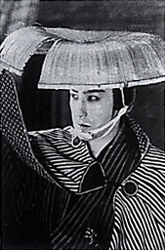 Though sometimes playing a rough tough fellow, in most of his early films Chiezo was extraordinarily handsome with an inherent sweetness in his appearance. Alas, for most of his early films this has to be judged from stills, since far too few pre-war films survived the war. Though sometimes playing a rough tough fellow, in most of his early films Chiezo was extraordinarily handsome with an inherent sweetness in his appearance. Alas, for most of his early films this has to be judged from stills, since far too few pre-war films survived the war.
Assessing films from stills, contemporary reviews, written scenarios or scripts, remakes, or in some cases the original source materials such as novels or plays, may or may not give a clear idea.
But in combination with the few examples that do survive, a good understanding can be had of which directors & actors were associated with stunningly good movies.
Chiezo looked like a sweety-pie in Inagaki's lost talkieTravels Under the Blue Sky (Tabi wa aozora, Chie Productions, 1932). And in the same director's double-film silent epic Yataro-gasa kohen: Kyorai no maki (Yataro Walks Alone, Chie Productions, 1932) & Yataro-gasa zenpen: Doppo no Maki, (Yataro's Sedge Hat, Chie Productions, 1932), Chiezo was mournful & pretty.
 The latter pair of "Yataro" films were eight reels each, forming a single, sentimental, epic-length toseinin-mono or wanderer's tale. The latter pair of "Yataro" films were eight reels each, forming a single, sentimental, epic-length toseinin-mono or wanderer's tale.
Judging just the silhouette still reproduced near this paragraph, & which concludes Part I, it's an easy assumption that this was a poetic film, & a tragic loss that it can never again be viewed.
Two other stills are reproduced here to give a sense of the film's style, a portrait of Chiezo in the role of Yataro with a sword-cut through his wanderer's sedgehat, & an action scene along the road in Part II with Yataro surrounded by would-be killers.
Generally toseinin of the yakuza or gambler world were one-sword men, not of samurai heritage, having no right to carry the second, shorter sword. But Yataro had formerly been a hatamoto, bannerman to the Shogun, & is known as "two-sword Yataro," preferring his free life of a wanderer over the responsibilities of a vassal.
In Part I Yataro has serial adventures, returning in time to the territory that belonged to a friend, the oyabun-godfather Torataro (Katsuragi Koichi), who was murdered while Yataro was away. It all culminates in his promise to Oyuki (Yamada Isuzu) to restore her father's gambling territory, wrested from her family by a cruel rival gang.
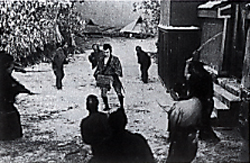 In Part II, Yataro's affection for the young woman Oyuki, rightful inheritor of her father's gambling territory, is further developed, & Yataro with violent finality takes care of the bad guys once & for all. In Part II, Yataro's affection for the young woman Oyuki, rightful inheritor of her father's gambling territory, is further developed, & Yataro with violent finality takes care of the bad guys once & for all.
Critics of the '30s thought it Inagaki's masterpiece, & his first truly complete work with depth of character as well as exciting action.
The character of Yataro was created by Kan Shimozawa who created the ultra-popular character Zatoichi. The original stories were serialized in the weekly Sunday Manaichi. Yataro gasa was filmed twelve times, Inagaki's film being the first, later popular versions starring Raizo Ichikawa in 1957, & Kinnosuke Nakamura in 1960.
Those two lost early talkies (Travels Under the Blue Sky & Yataro's Sedge Hat) are said to have been among the first chambara films to give the protagonist sufficient depth of character that it was actually possible for the hero to fail upon occasion.
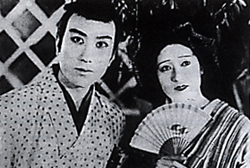 Another eight-reel feature film forever lost to us is Hanabi (Fireworks, Chie Productions, 1931), which can now be judged only by its surviving screenplay & a few still photographs. A still is shown here, with Chiezo next to his co-star.
Another eight-reel feature film forever lost to us is Hanabi (Fireworks, Chie Productions, 1931), which can now be judged only by its surviving screenplay & a few still photographs. A still is shown here, with Chiezo next to his co-star.
With what must have seemed revolutionary to "heroic" storytelling at the time, Chiezo played a cowardly samurai, whose honor is on the line when it becomes necessary to avenge the murder of his father.
The culminating duel took place on a night of fireworks, which was praised by contemporary critics for the visual excellence.
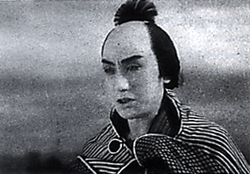 Yet another lost treasure is Ippongatana Dohyoiri (Into the Sumo Ring with a Sword; aka, The Sword & the Sumo Ring, Chie Productions, 1931), which was, along with Hanabi, on the Kinema Jumpo list of ten best films of the year. Yet another lost treasure is Ippongatana Dohyoiri (Into the Sumo Ring with a Sword; aka, The Sword & the Sumo Ring, Chie Productions, 1931), which was, along with Hanabi, on the Kinema Jumpo list of ten best films of the year.
Again a few stills survive (one of which reproduced near this paragraph), & contemporary reviews, by which to assess what audiences may never again see, & perhaps the post-war remakes by directors well acquainted with the original.
And again Chiezo played a failure who must overcome his weakness. Kicked out of the sumo school for ineptitude, he wanders homeless & hungry in tattered kimono, until Otsuta (Naoe Fushima), a maiden at an inn, takes pity on him, & bestows upon him her few wordly possessions.
She encourages him to continue to study sumo & become a great wrestler, which alas he continues to fail to do. However, he eventually proves his courage when Otsuta & her family are in peril. In the end our would-be wrestler reconfirms his commitment to pursuing a wrestler's occupation.
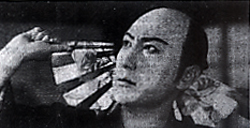 Byakuya no utage; aka, Byakuya no kyoen (Banquet Under the Midnight Sun; aka, Banquet of the White Night, Chie Productions, 1932), was a an epic length silent film at twelve reels. Byakuya no utage; aka, Byakuya no kyoen (Banquet Under the Midnight Sun; aka, Banquet of the White Night, Chie Productions, 1932), was a an epic length silent film at twelve reels.
It is again known from a surviving screenplay with detailed instructions for scenes, a few surviving stills, & contemporary reviews.
In old Edo, Kakunojo (Chiezo), a dandy about town, falls in love with Oichi (Isuzu Yamada), whose merchant family is much beyond Kakunojo's status.
He nevertheless pursues her until her initial disgust breaks down into fondness, then romantic feelings, inducing her to abandon her fiance on their wedding day.
This was the last film Chiezo made with the pioneering chambara director Masahiro Makino. Audiences were surprised, & a few were disappointed, that an action film star with action film director made a period love story with only token action.
Chiezo with his own company, having already successfully proven an action film could be about character too, also wanted to show that a period film could be exclusively about character. It made the Kinema Jumpo top ten list for its year.
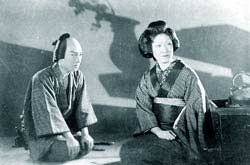 0ne of Inagaki's early films which does survive intact is Memories of Mother (Banba no Chutaro: Mabuta no Haha, Chie Productions, 1931), by which we might get an idea of the quality of films lost first to a major earthquake & the rest to wartime fire-bombing of cities. 0ne of Inagaki's early films which does survive intact is Memories of Mother (Banba no Chutaro: Mabuta no Haha, Chie Productions, 1931), by which we might get an idea of the quality of films lost first to a major earthquake & the rest to wartime fire-bombing of cities.
In this film Chiezo plays toseinin or wanderer Chutaro searching for his long lost mother (Misako Tokiwa). He is drawn to any woman about her age. Playing his sister is a teenaged Isuzu Yamada.
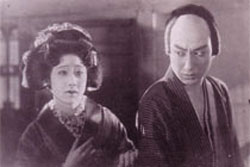 Shown also as In Search of Mother, The Mother He Never Knew; or, Chutaro's Lost Mother. It is one of the most important sentimental period films to survive intact from Japan's silent era. Shown also as In Search of Mother, The Mother He Never Knew; or, Chutaro's Lost Mother. It is one of the most important sentimental period films to survive intact from Japan's silent era.
The story was written in 1931 for the Kabuki stage, based on the life of the playwright, orphaned Shin Hasegawa.
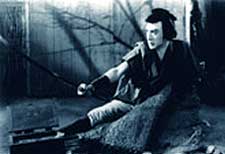 It was amost immediately adapted to the cinema, then remade in 1935 starring Kazuo Hasegawa, in 1936 with Chiezo reprising the role, & in 1955 starring Tomisaburo Wakayama. It was remade for the first time in color by Tai Kato, In Search of Mother (Mabuta no haha, 1962) starring Kinnosuke Nakamura. It was amost immediately adapted to the cinema, then remade in 1935 starring Kazuo Hasegawa, in 1936 with Chiezo reprising the role, & in 1955 starring Tomisaburo Wakayama. It was remade for the first time in color by Tai Kato, In Search of Mother (Mabuta no haha, 1962) starring Kinnosuke Nakamura.
With the trilogy Chuji Kunisada (Chie Productions, 1933), Inagaki was making the first sound-version of Daisuke Ito's silent trilogy A Diary of Chuji's Travels (Chuji tabinikki, 1927), & chose Chiezo to insure the remake the same success as the original.
Chuji was a Tokaido road bandit, a period yakuza hero. Though Inagaki's Chuji trilogy does not survive, Chiezo would make Chuji thereafter one of several characters he was identified & would play in multiple films (see for example Chuji Kunisada: On National Authority (1958), & similar yakuza boss figures.
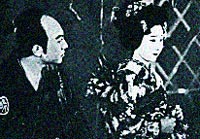 Chiezo was noted for humane characterizations right from the beginning of his career. When he established his own film studio, he went after directors who could bring a compassionate dimension to samurai films, & so he went for Mansaku Itami, whose humorous & humane work as a scriptwriter & director is easily surmised from what little survives of his output. Chiezo was noted for humane characterizations right from the beginning of his career. When he established his own film studio, he went after directors who could bring a compassionate dimension to samurai films, & so he went for Mansaku Itami, whose humorous & humane work as a scriptwriter & director is easily surmised from what little survives of his output.
Mansaku's son was Juzo Itami, a film actor in the 1960s, & a very popular director in the 1980s with such classic films as A Taxing Woman (1987) & Tampopo (1986), cutting short his own career when he committed suicide leaping from Tokyo condominium in 1992.
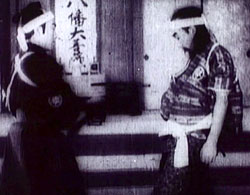 Mansaku Itami's daughter Yukari Oe is a water colorist & book illustrator, wife of the internationally known author Kenzaburo Oe, with whom she co-wrote a bestseller on raising a handicapped son. Mansaku Itami's daughter Yukari Oe is a water colorist & book illustrator, wife of the internationally known author Kenzaburo Oe, with whom she co-wrote a bestseller on raising a handicapped son.
In Mansaku Itami's silent Peerless Patriot; aka, The Unrivaled Hero; or Muso the Patriot; or, The Unmatched (Kokushi Muso, Chie Productions, 1932) he was a man of action, but with a heart.
Only a twenty-one minute fragment of the film survives, of a tale that satirically obliterates the feudal notion of a samurai's devotion to his lord.
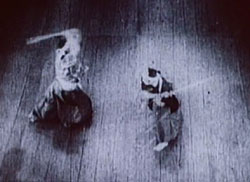 A young samurai (Chiezo) pretending to be the famous swordmaster Isenokami meets the real guy, & ends up in a duel within a dojo. A young samurai (Chiezo) pretending to be the famous swordmaster Isenokami meets the real guy, & ends up in a duel within a dojo.
Though using only a stick to fight the master, the imposter keeps disarming his "better," so easily overwhelming his insistent opponent until it becomes almost whimsical.
He generously keeps returning the master's wood sword to him, in order to continue the duel, to a glad ending with no one injured.
This is also an early special effect film, since Chiezo plays both duelists. Part of this fragment can be seen on dvd in the documentary of Chiezo's fellow film idol, Bantsuma: The Life of Tsumasaburo Bando (Bantsuma: Bando Tsumasaburo no Shogai, 1980). His son Juzo Itami made an English-subtitled print available in the 1980s.
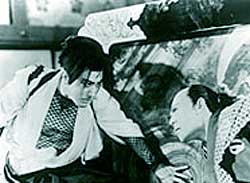 A handful of films based on Itami's scripts survive, but his only directed film to survive in its entirety is Capricious Young Man (Kakita Akanishi, 1936), a lampoon of samurai manners set in the 1660s, based on a classic tale by Naoya Shiga (1883-1971).
A handful of films based on Itami's scripts survive, but his only directed film to survive in its entirety is Capricious Young Man (Kakita Akanishi, 1936), a lampoon of samurai manners set in the 1660s, based on a classic tale by Naoya Shiga (1883-1971).
In this Chiezo plays a country samurai out of place in the city. He ends up in a run-down tenement amidst commoners, in a situation reminiscent of the oft-filmed Roningai, except the ronin of Roningai can fight when it comes down to it, & Kakita is a samurai strictly by class, not skill.
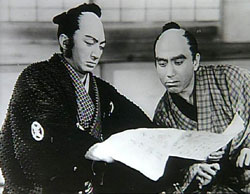 As a swordsman he's not skilled, & in his life he is pretty much of a failure. Breaking all the rules for expected content of tales of heroic samurai, he might as easily have been a short order cook. As a swordsman he's not skilled, & in his life he is pretty much of a failure. Breaking all the rules for expected content of tales of heroic samurai, he might as easily have been a short order cook.
His one & only friend is his cat, & no one will play shogi with him, so he sets up the chess board & plays all by himself. Yet he is to the core a decent man.
Eventually happiness does find him in the form of love, an almost revolutionary outcome for a samurai film of the day, when action resolutions were de rigour.
For such work, Itami is credited, together with Sadao Yamanaka who directed Humanity & Paper Balloons (1937), with bringing a deep sensitivity to a genre that tended toward all-action.
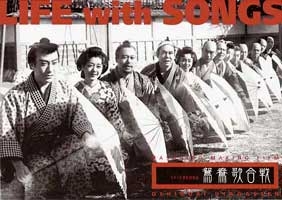 If Chiezo's roles were among the first to bring humanity to the sword-slashing milieu, his roles were also among the first to question the romance of feudalism, as in his gambler-against-the-system characterizations under Daisuke Ito's or Hiroshi Inagaki's direction.
If Chiezo's roles were among the first to bring humanity to the sword-slashing milieu, his roles were also among the first to question the romance of feudalism, as in his gambler-against-the-system characterizations under Daisuke Ito's or Hiroshi Inagaki's direction.
Today we know Inagaki chiefly for his archly commercial post-war chambara & especially for his color remake of the Samurai Trilogy starring Toshiro Mifune as Miyamoto Musashi, a role Chiezo had formerly been best known for.
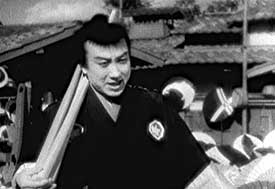 Well before his "color epics" career, Inagaki made much more down-to-earth & artful movies. Well before his "color epics" career, Inagaki made much more down-to-earth & artful movies.
In Inagaki's first version of Musashi Miyamoto (1942), Chiezo was beginning to look tough & weathered rather than pretty, but no less handsome than Toshiro Mifune in the same part twelve years later.
By the time Chiezo starred in Tomu Uchida's visually stunning A Bloody Spear at Mount Fuji (Chiyari Fuji, 1955), he had lost his good looks, if "good looks" is measured by youthful beauty.
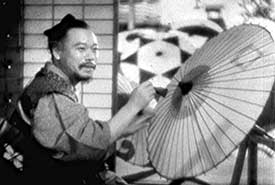 But to the end of the 1930s, he was the classic leading man for looks. He was even one of the original "singing samurai" in a classic of lightheartted song & dance, The Singing Lovebirds; aka, Life with Song (Oshidori Utagassen, 1939). But to the end of the 1930s, he was the classic leading man for looks. He was even one of the original "singing samurai" in a classic of lightheartted song & dance, The Singing Lovebirds; aka, Life with Song (Oshidori Utagassen, 1939).
It has been known by several other titles, including Samurai Musical, Bird Song, or The Geese & the Ducks Singing Contest. It's Japan's Singing in the Rain.
Chiezo plays the impoverished but happy-go-lucky ronin Reisaburo Asai. He is pursued for his good looks & gentle habits by competing girlfriends, all to the jazzy often satirically sophisticated tunes of Okubo Tokujiro.
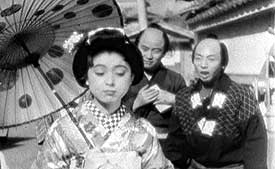 The great character actor Takeshi Shimura (1905-1982) plays the umbrella maker Kyosai, father of one of the girls. The great character actor Takeshi Shimura (1905-1982) plays the umbrella maker Kyosai, father of one of the girls.
During the shoot Chiezo came down with appendicitis, so Shimura's role was quickly expanded. He becomes the star of the second half.
A subtitled print is in circulation & it is available unsubtitled on dvd, including a 2-disc Nikkatsu limited edition with lots of extras.
But it's still awaiting a release with removable subtitles. It deserves a much broader circulation & reputation.It's a beautifully done all-out musical that cannot help but please.
During the war in China then in the Pacific, the military establishment demanded samurai films from the studios, of the type that made obedience, sacrifice, & death appear to be the highest achievement.
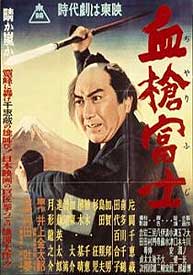 Directors who failed would be sent to the front in China or Manchuria & probably die, as happened to such sensitive directors as Sadao Yamanaka. Directors who failed would be sent to the front in China or Manchuria & probably die, as happened to such sensitive directors as Sadao Yamanaka.
During the Occupation, Chiezo's career came to a screeching halt, because McArthur agreed with the Japanese military establishment that samurai movies encouraged warlike spirit. The careers of Utaemon Ichikawa (1907-1999) & Ryutaro Otomo (1912-1985) likewise experienced a long break until McArthur was gone.
The great tide of samurai films would not return until the end of the Occupation, when Chiezo would make a big come-back at Toei, proving he was still box-office in the gruelling cruel tale of the Bloody Spear on Mount Fuji (Chiyari Fuji, 1955). Otomo & Ichikawa would also experience resurged careers at Toei, as would a number of jidaigeki directors.
In his post-Occupation films, Chiezo's face had become something extraordinary & expressive & versatile, a sort of "poor man's Takashi Shimura," no longer the young attractive leading man he still seemed to be even in his thirties. That mature face nevertheless retained something adorable, somewhere between grandfatherly gentleness & patrician authority.
He remained an actor who could deliver phenomenal leading parts for years to come. Though relegated in some of his films to supporting star to up & coming whipper snappers like Hashizo Okawa & Kinnosuke Nakamura, he was simultaneously starring in films like the "Cherry Blossom Judge" film series & similar "samurai detective" films.
The extent of his post-war success is obvious from Tomu Uchida's version of the Daibosatsu toge trilogy; his revisits to toseinin-mono tales of period gambler bosses like Chuji Kunisada or Jirocho of Shimizu; starring roles in new versions of Chushingura & Shinsengumi; & so much else before even looking at the whelter of support-roles to younger actors.
copyright © by Paghat the Ratgirl
|
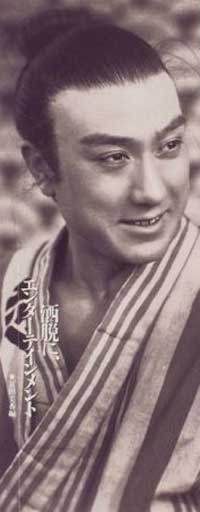

 In the surviving The Wandering Gambler, Chiezo looked fierce & wild, & drew on his kabuki stage experience to create amazing stances & ferocious action, resulting in untidiness of costume & weary broken movements such as heros were generally not permitted to show.
In the surviving The Wandering Gambler, Chiezo looked fierce & wild, & drew on his kabuki stage experience to create amazing stances & ferocious action, resulting in untidiness of costume & weary broken movements such as heros were generally not permitted to show.
 The latter pair of "Yataro" films were eight reels each, forming a single, sentimental, epic-length toseinin-mono or wanderer's tale.
The latter pair of "Yataro" films were eight reels each, forming a single, sentimental, epic-length toseinin-mono or wanderer's tale. In Part II, Yataro's affection for the young woman Oyuki, rightful inheritor of her father's gambling territory, is further developed, & Yataro with violent finality takes care of the bad guys once & for all.
In Part II, Yataro's affection for the young woman Oyuki, rightful inheritor of her father's gambling territory, is further developed, & Yataro with violent finality takes care of the bad guys once & for all.
 Yet another lost treasure is Ippongatana Dohyoiri (Into the Sumo Ring with a Sword; aka, The Sword & the Sumo Ring, Chie Productions, 1931), which was, along with Hanabi, on the Kinema Jumpo list of ten best films of the year.
Yet another lost treasure is Ippongatana Dohyoiri (Into the Sumo Ring with a Sword; aka, The Sword & the Sumo Ring, Chie Productions, 1931), which was, along with Hanabi, on the Kinema Jumpo list of ten best films of the year. Byakuya no utage; aka, Byakuya no kyoen (Banquet Under the Midnight Sun; aka, Banquet of the White Night, Chie Productions, 1932), was a an epic length silent film at twelve reels.
Byakuya no utage; aka, Byakuya no kyoen (Banquet Under the Midnight Sun; aka, Banquet of the White Night, Chie Productions, 1932), was a an epic length silent film at twelve reels.
 Shown also as In Search of Mother, The Mother He Never Knew; or, Chutaro's Lost Mother. It is one of the most important sentimental period films to survive intact from Japan's silent era.
Shown also as In Search of Mother, The Mother He Never Knew; or, Chutaro's Lost Mother. It is one of the most important sentimental period films to survive intact from Japan's silent era. It was amost immediately adapted to the cinema, then remade in 1935 starring Kazuo Hasegawa, in 1936 with Chiezo reprising the role, & in 1955 starring Tomisaburo Wakayama. It was remade for the first time in color by Tai Kato,
It was amost immediately adapted to the cinema, then remade in 1935 starring Kazuo Hasegawa, in 1936 with Chiezo reprising the role, & in 1955 starring Tomisaburo Wakayama. It was remade for the first time in color by Tai Kato, 
 Mansaku Itami's daughter Yukari Oe is a water colorist & book illustrator, wife of the internationally known author Kenzaburo Oe, with whom she co-wrote a bestseller on raising a handicapped son.
Mansaku Itami's daughter Yukari Oe is a water colorist & book illustrator, wife of the internationally known author Kenzaburo Oe, with whom she co-wrote a bestseller on raising a handicapped son. A young samurai (Chiezo) pretending to be the famous swordmaster Isenokami meets the real guy, & ends up in a duel within a dojo.
A young samurai (Chiezo) pretending to be the famous swordmaster Isenokami meets the real guy, & ends up in a duel within a dojo.
 As a swordsman he's not skilled, & in his life he is pretty much of a failure. Breaking all the rules for expected content of tales of heroic samurai, he might as easily have been a short order cook.
As a swordsman he's not skilled, & in his life he is pretty much of a failure. Breaking all the rules for expected content of tales of heroic samurai, he might as easily have been a short order cook.
 Well before his "color epics" career, Inagaki made much more down-to-earth & artful movies.
Well before his "color epics" career, Inagaki made much more down-to-earth & artful movies. But to the end of the 1930s, he was the classic leading man for looks. He was even one of the original "singing samurai" in a classic of lightheartted song & dance, The Singing Lovebirds; aka, Life with Song (Oshidori Utagassen, 1939).
But to the end of the 1930s, he was the classic leading man for looks. He was even one of the original "singing samurai" in a classic of lightheartted song & dance, The Singing Lovebirds; aka, Life with Song (Oshidori Utagassen, 1939). The great character actor Takeshi Shimura (1905-1982) plays the umbrella maker Kyosai, father of one of the girls.
The great character actor Takeshi Shimura (1905-1982) plays the umbrella maker Kyosai, father of one of the girls. Directors who failed would be sent to the front in China or Manchuria & probably die, as happened to such sensitive directors as Sadao Yamanaka.
Directors who failed would be sent to the front in China or Manchuria & probably die, as happened to such sensitive directors as Sadao Yamanaka.